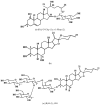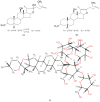Alliums as Potential Antioxidants and Anticancer Agents
- PMID: 39125648
- PMCID: PMC11312234
- DOI: 10.3390/ijms25158079
Alliums as Potential Antioxidants and Anticancer Agents
Abstract
The genus Allium plants, including onions, garlic, leeks, chives, and shallots, have long been recognized for their potential health benefits, particularly in oxidative and cancer prevention. Among them, onions and garlic have been extensively studied, unveiling promising biological activities that are indicative of their potential as potent antioxidant and anticancer agents. Research has revealed a rich repository of bioactive compounds in Allium species, highlighting their antioxidative properties and diverse mechanisms that target cancer cells. Compounds such as allicin, flavonoids, and organosulfur compounds (OSCs) exhibit notable antioxidant and anticancer properties, affecting apoptosis induction, cell cycle arrest, and the inhibition of tumor proliferation. Moreover, their antioxidant and anti-inflammatory attributes enhance their potential in cancer therapy. Studies exploring other Allium species beyond onions and garlic have revealed similar biological activities, suggesting a broad spectrum of natural products that could serve as promising candidates for developing novel anticancer treatments. Understanding the multifaceted potential of Allium plants will pave the way for innovative strategies in oxidative and cancer treatment and prevention, offering new avenues for pharmaceutical research and dietary interventions. Therefore, in this review, we compile an extensive analysis of the diversity of various Allium species, emphasizing their remarkable potential as effective agents.
Keywords: Allium; anticancer; antioxidants; bioactive compounds; edible.
Conflict of interest statement
The authors declare no conflicts of interest.
Figures





References
-
- POWO Plants of the World Online. [(accessed on 1 May 2024)]. Available online: http://www.plantsoftheworldonline.org/
-
- Danquah C.A., Minkah P.A.B., Agana T.A., Moyo P., Ofori M., Doe P., Rali S., Osei Duah Junior I., Amankwah K.B., Somuah S.O. The phytochemistry and pharmacology of Tulbaghia, Allium, Crinum and Cyrtanthus:‘talented’taxa from the Amaryllidaceae. Molecules. 2022;27:4475. doi: 10.3390/molecules27144475. - DOI - PMC - PubMed
-
- Peterson J. The Allium species (onions, garlic, leeks, chives, and shallots) Camb. World Hist. Food. 2000;1:249–271.
-
- Sood S.K., Parmar S., Lakhanpal T. Ethnic Plants of India Used in Cancer Cure—A Compendium. Bishen Singh Mahendra Pal Singh; Dehra Dun, India: 2005.
Publication types
MeSH terms
Substances
LinkOut - more resources
Full Text Sources
Medical

